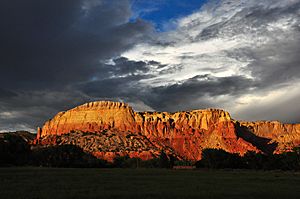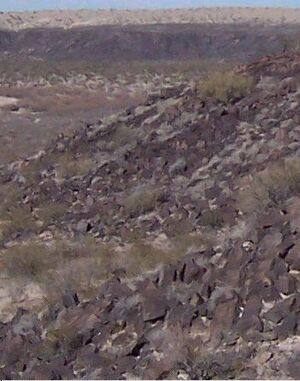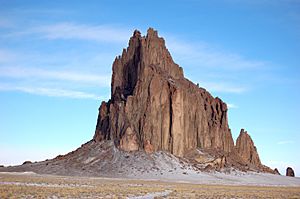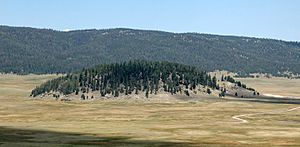List of National Natural Landmarks in New Mexico facts for kids
New Mexico is home to 12 amazing places called National Natural Landmarks. These are special spots recognized by the United States government for their unique natural features. They help us understand Earth's history and its incredible natural processes.
Contents
Discovering New Mexico's Natural Wonders
New Mexico has many different landscapes, from deserts to mountains. Its National Natural Landmarks show off some of the most interesting and important natural features in the state.
Border Hills Structural Zone
Designated in 1980, the Border Hills Structural Zone is in Lincoln County. This area shows a special type of fault called 'wrench faulting'. It's rare to see this kind of faulting outside of places like the California coast.
Bitter Lake Group
Also designated in 1980, the Bitter Lake Group is located in Chaves County. These are salty lakes fed by underground springs. They are home to a unique type of algae usually found in the ocean, and two kinds of rare fish. This makes them a very important habitat.
Bueyeros Shortgrass Plains
The Bueyeros Shortgrass Plains, designated in 1980, can be found in Harding County. This landmark is a great example of the natural prairie lands found in the Great Plains. It features a mix of blue grama and buffalograss, which are important native grasses.
Fort Stanton Cave
Designated in 1980, Fort Stanton Cave is in Lincoln County. This cave is famous for its unique mineral formations. You can find beautiful selenite needles, starburst shapes, and velvet-like flowstone here. It's part of a larger conservation area.
Grants Lava Flow
The Grants Lava Flow was designated in 1969 and is located in Valencia County. This area is one of the best places to see how volcanoes have shaped the land recently. It's a great example of lava that has flowed out of the Earth's surface. Part of it is within the El Malpais National Conservation Area.
Ghost Ranch
Designated in 1975, Ghost Ranch is in Rio Arriba County. This site is famous for its fossils. Many well-preserved skeletons of a dinosaur called Coelophysis were found here. It's a very important place for understanding ancient life.
Kilbourne Hole
Kilbourne Hole was designated in 1975 and is located in Doña Ana County. This landmark is a great example of a volcanic feature called a maar. A maar is a wide, flat-bottomed crater formed by a volcanic explosion.
Mathers Research Natural Area
Designated in 1980, the Mathers Research Natural Area is in Chaves County. This area is considered the best example of a "shinnery oak-sand prairie" community. This unique habitat is found in the southern Great Plains.
Mescalero Sands South Dune
The Mescalero Sands South Dune was designated in 1982 and is also in Chaves County. This landmark is the best example of an active sand dune system in the southern Great Plains. It shows how sand dunes move and change over time.
Ship Rock
Ship Rock was designated in 1975 and is located in San Juan County. This amazing natural feature is an outstanding example of an exposed volcanic neck. It's the hardened core of an ancient volcano, with rock formations called dikes spreading out from it.
Torgac Cave
Torgac Cave was designated in 1974 and is in Lincoln County. This cave is known for its very special formations. It has distinctive branching stalactites and helictites. Helictites are unusual cave formations that seem to defy gravity. Torgac Cave is the place where a specific type of helictite, called "Torgac-type helictites," was first identified.
Valles Caldera
Designated in 1975, the Valles Caldera spans Rio Arriba and Sandoval counties. This landmark is one of the largest calderas in the world. A caldera is a huge bowl-shaped depression formed when a volcano collapses after a massive eruption.





